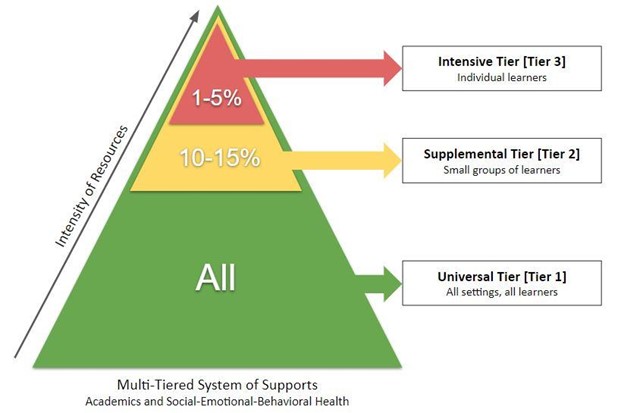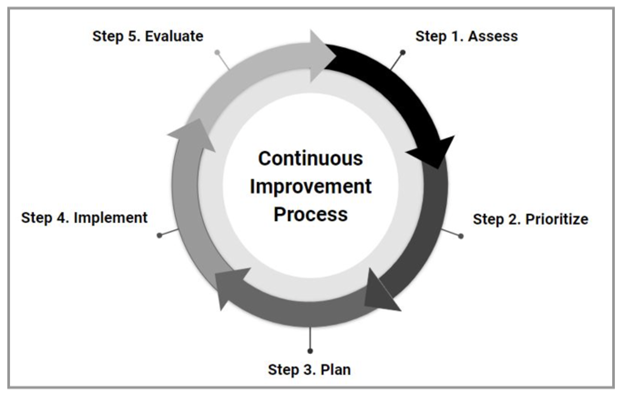This is the first blog post in a series of three that detail the process of differentiating Tier 1 instruction through flexible, skill-based grouping. Before we jump into the actual grouping process, we want to make sure that we start from the top and tap into the strong structures that exist in Iowa: Multi-Tiered System of Supports and the Continuous Improvement Process.
The Iowa Department of Education has adopted a framework and a process for continuous improvement for use by Iowa schools. Multi-Tiered System of Supports (MTSS) is Iowa’s framework for continuous improvement and, as the name suggests, the Continuous Improvement Process (CIP) is Iowa’s process. These are described within the Universal Tier Guide and also on the ESSA Support Site. Familiarizing ourselves with these resources is the first step in ensuring we make instructional decisions that meet students' needs.
Multi-Tiered System of Supports (MTSS)
MTSS is a framework for using data to make instructional decisions that improve all students' academic, social, emotional, and behavioral health and prepare them for the future. The tiers in MTSS are referred to as Tier 1, Tier 2, and Tier 3, which represent the intensity of resources needed to meet the needs of learners. As defined by the Iowa Department of Education, those tiers may be referred to as:
- Universal Tier (Tier 1): This tier refers to the instruction, services, and supports that are accessible to all learners. Universal instruction is for all students.
- Supplemental Tier (Tier 2): This tier is based on the instruction, services, and supports students access in Universal Tier instruction, but it focuses on learners who need additional resources to be successful. Around 15-20% of learners will need supplemental support in a small-group setting. Supplemental instruction is for groups of learners.
- Intensive Tier (Tier 3): This tier is based on the instruction, services, and supports students access in Universal Tier instruction, but it focuses on learners who need more intensive support. Around 5-10% of learners will need intensive support in a one-on-one setting. Intensive instruction is for individual learners.
The MTSS framework is visualized as a three-tiered pyramid, as shown in the figure below. The tiers represent the intensity of resources needed to meet the needs of learners.
Iowa’s Multi-Tiered System of Supports Framework for Continuous Improvement

Note. Reprinted from “Iowa’s Framework and Process to Support Schools,” by the Iowa Department of Education, n.d. (https://docs.google.com/document/d/1rZ83xVtmXS0mFtPNSXnoV1X6dYTYjHFn-x3tEQAajMk/edit#heading=h.ch8ya7e1djnl). Copyright Iowa Department of Education. Reprinted with permission.
As described by the Iowa Department of Education (n.d.), “This tiered framework seeks to focus resources where they are most needed, remove barriers, use evidence-based practices to support all learners, and target supplemental and intensive interventions—all based on data” (p. 2). This framework guides decision-making at all levels of the educational system, which is why Educational Consultant Dr. Stephanie Stollar refers to the three-tiered model as “the heart of a school-wide literacy improvement approach” (Stollar, 2020). This is a critical framework for systems as well. Together with the continuous improvement process, these structures help identify system-level needs from the educator level all the way up to the district level.
Iowa’s Continuous Improvement Process (CIP)
Iowa’s Continuous Improvement Process (CIP) is a process that supports teams in a system to understand current needs, identify goals, and prioritize evidence-based ways to improve and develop, implement, and evaluate a plan of action in a continuous cycle. There are five steps involved in the CIP—with corresponding questions—that can be used at the individual student, classroom, school, district, and state level across many different areas of focus:
- Step 1 - Assess: Where are we now, and where do we want to be?
- Step 2 - Prioritize: Why?
- Step 3 - Plan: What are we going to do, and how are we going to do it?
- Step 4 - Implement: Are we doing what we said we would do?
- Step 5 - Evaluate: Did our plan work?
Iowa’s 5-Step Continuous Improvement Process

Note. Reprinted from “Iowa’s Framework and Process to Support Schools,” by the Iowa Department of Education, n.d. (https://docs.google.com/document/d/1rZ83xVtmXS0mFtPNSXnoV1X6dYTYjHFn-x3tEQAajMk/edit#heading=h.ch8ya7e1djnl). Copyright Iowa Department of Education. Reprinted with permission.
As described by the Iowa Department of Education (n.d.), “In practice, Iowa's MTSS framework, data-based decision-making, and CIP are nearly impossible to separate (p. 4). Throughout this series, we will illustrate how this process works in practice and how educators can use these structures to keep the focus on data-based decision-making and meet the needs of our students.
As mentioned above, this process can be used at any level (see this resource for an example of what this looks like at different levels), though we want to bring attention to using this model at the building level. As we move forward in this blog series, our focus will be mainly on Tier 1 instruction with an emphasis on flexible, skill-based groups. To make changes to Tier 1 instruction, building-level teams are going to have to ask themselves those questions highlighted above. Ultimately, the answer to “Where do we want to be?” is: Tier 1 instruction should cause 80% or more of our students to meet grade-level expectations. Our short answer on how to achieve that is to differentiate Tier 1 instruction so that it is aligned with the needs of each student based on data gathered to inform instruction. But, realistically, there are many decisions that need to be made before that can happen. That takes us to Step 3 in the CIP: Plan. What are we going to do, and how are we going to do it? We will address this question in the next post in the series.
References
Iowa Department of Education. (n.d.). Iowa’s framework and process to support schools: Multi-tiered system of supports and continuous improvement process. https://docs.google.com/document/d/1rZ83xVtmXS0mFtPNSXnoV1X6dYTYjHFn-x3tEQAajMk/edit#heading=h.wd0jvchp8b2l
Stollar, S. (October 8, 2020). Reading Science Academy School-Wide Literacy Model [Lecture]. Reading Science Academy. https://www.readingscienceacademy.com/products/reading-science-academy-membership/categories/4685500/posts/12677492
